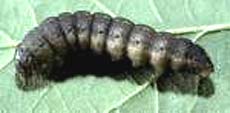|
Normally we think of
black cutworms as early-season insects. Cutworms are working in
cornfields now, with some corn as tall as 12 inches being cut. Corn
cut above the growing point will regrow and be fine, while corn cut
below ground or below the growing point will be a loss for the plant
cut. In addition to cutting corn, cutworms can spot feed and damage
the growing point causing a loss.
Rescue treatments for
cutworms should be applied when 3 percent of the plants are cut and
there are larvae present. Several insecticides provide good control
of cutworms when moisture is adequate, so that cutworms arenít just
cutting below the soil surface. Also, you need to know what type of
cutworm is causing damage. Variegated cutworms cut leaves and plant
tops but donít completely cut plants off. Black, sandhill, and
clayback cutworms usually cut entire plants.
We have also seen
delayed damage from wireworms, grubs and grape colaspis. Many of
these insects developed slower due to the very cool soil conditions
this year during the spring months. By now, most of the grubs and
colaspis have pupated ó meaning they will soon change to adult
stages, if they havenít already.
 [to top of second column in this
article]
|

There are many weeks
before the reproductive stages begin for corn, and then months
before the combines roll. When crop reports are seen at this time,
you have to take them with a grain of salt since a lot of things can
happen. Just ask the Freeport area with 7 inches of water in a
weekend. As for our prospects, they look OK at this point, but time
will tell.

[Photo provided by John Fulton]
Plots and
research in the county
Each year the
Extension office coordinates many demonstration and research plots
in the county. This year these would include: "Nitrogen and Manure
Rate Study on Corn," "Amino Sugar Soil Analysis and Nitrogen
Application on Corn," "Value-Added Traits Yield Plot ó Corn,"
"Perennial Weed Control Programs For Corn and Soybeans," and the
"Commercial Corn Variety Yield Plot."
Information from many of these plots goes
into the University of Illinois Research System and is distributed
in many ways. The commercial variety corn plot will have local
information as well as a fall field day. If you would like more
information on any of these demonstration and research efforts,
please feel free to e-mail
fultonj@uiuc.edu.
[John Fulton]
|
|
"Assembling an
extensive and genetically diverse collection of soybean pathogens in
one location would provide an invaluable resource for identifying
new genes for resistance in soybeans and understanding the genetics
of the pathogens that cause major soybean diseases," said Glen
Hartman, USDA plant pathologist at the University of Illinois. "In
recent years, it has become abundantly clear that such a collection
is essential if we are to protect the long-term productivity of the
soybean in the U.S."
To meet this need,
Hartman and other collaborators across the country have recently
begun assembling just such a collection at the U of Iís National
Soybean Research Laboratory. The National Soybean Pathogen Center
will focus on collecting, maintaining and studying a wide range of
bacterial, fungal, nematode and viral pathogens.
Initial support for
the project came from the United Soybean Board, the American Seed
Trade Association and the USDA Agricultural Research Service. Recent
funding includes a grant from the USDA-IFASF Program.

"The main function of
the center is to provide soybean pathogens to researchers who are
working on host resistance as a means of reducing yield losses
caused by disease," Hartman said. "The center also will widely
disseminate information about the accessions in the collection and
present workshops so that researchers can work more efficiently with
the pathogens."
The center is
committed to maintaining the soybean pathogens in a viable and
stable state, while maintaining all original properties. The
collection will serve as a reference collection for researchers in
both the public and private sectors.
"We will describe and
document the variations in the soybean pathogens from our
collection," Hartman said. "All that information will be made
readily available to other interested researchers. We also will
assist other scientists in identifying soybean pathogens and
studying variations among the samples in the collection as they
relate to understanding pathogen biology and the interactions with
the hosts."
 [to top of second column in this
article]
|

Hartman notes that
the collection will include living pathogens, representing the range
of genetic diversity within bacteria, fungi, nematodes and viruses
that are considered important for improving soybean germplasm. Other
programs at the center will focus on training in germplasm screening
and developing research strategies for better understanding pathogen
diversity.
"An accession number
will be allocated to each incoming strain," he said. "Those that are
further purified or selected will be assigned a new accession
number. A top priority will be to maintain the identity and
viability of the strains in the collection. Some pathogens will be
maintained as frozen stock, while others may be kept on living plant
material."
Accessions in the
collection will be distributed through an online catalogue without
any charge. The collection will housed at the National Soybean
Research Center at the U of I. Other cooperators on the project will
maintain duplicate collections at several different locations.
He further points out
that the location of the center at the NSRC provides ready access to
the USDA Soybean Germplasm Collection at the U of I.

"This unique collection contains more
than 16,000 soybean accessions and more than 1,000 accessions of the
progenitor of the soybean," Hartman said. "The germplasm collection
also has about 1,000 accessions of the wild perennial Glycine
species. We expect to have strong collaboration between the curator
of the germplasm collection and the scientists working with the
pathogen collection, all of which should prove of great benefit for
soybean producers as new resistant soybean varieties are developed
and released."
[News
release]
|